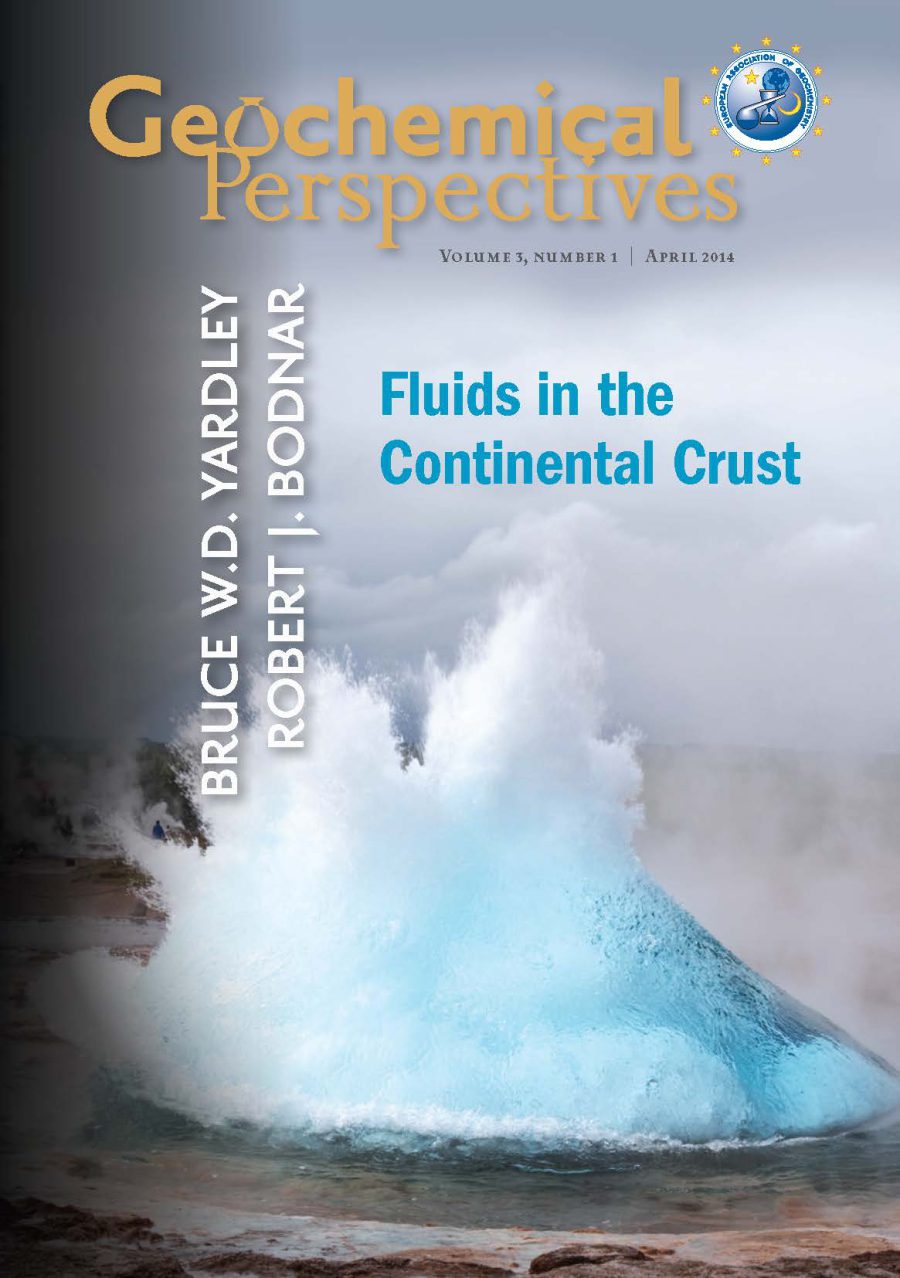
Fluids in the Continental Crust
by Bruce W.D. Yardley1 and Robert J. Bodnar2doi: 10.7185/geochempersp.3.1 | Volume 3, – April 2014, Number 1 (pages 1-127)
Abstract
Fluids play a critical role in the geochemical and geodynamical evolution of the crust, and fluid flow is the dominant process associated with mass and energy transport in the crust. In this Perspectives, we summarise the occurrence, properties and role that fluids play in crustal processes, as well as how geoscientists’ understanding of these various aspects of fluids have evolved during the past century and how this evolution in thinking has influenced our own research careers.
Despite the wide range of possible fluid sources in the crust, fluids in sedimentary, magmatic and metamorphic environments are all approximated by the system H2O – “gas” – “salt” and normally reflect equilibrium with rocks and melts at the relevant PT conditions. The “gas” component in many environments is dominated by CO2, but CH4, as well as various sulphur and nitrogen-rich gases, may also be important. The major “salt” components are usually NaCl and/or CaCl2, but salts of K, Mg and Fe can be major components in specific circumstances. While the activities of many fluid components can often be calculated assuming equilibrium with coexisting minerals, salinity is normally unbuffered and must be determined independently from observations of fluid inclusions.
Solubilities of “gas” and “salt” in H2O generally rise with increasing temperature and/or pressure, but in many environments compositions are such that phase separation (immiscibility or boiling) leads to the development of salt-rich aqueous fluids coexisting with a volatile-rich phase. Chloride content, buffering assemblages, temperature and, to a lesser extent pressure, all play a role in determining the dissolved load of crustal fluids. In addition to equilibrium considerations, kinetic factors can play an important role in relatively shallow, low temperature environments.
The most important distinction between relatively shallow basinal or geothermal fluids and deeper metamorphic or magmatic ones is the physical behaviour of the fluid(s). In regions where fluid pressure corresponds to hydrostatic pressure, extensive circulation of fluid is possible, driven by thermal or compositional gradients or gravity. In contrast, at greater depths where fluids are overpressured and may approach lithostatic pressure, fluid can only escape irreversibly and so fluxes are generally much more limited.
Much of our understanding of crustal fluids has come from studies of ore-forming systems that are present in different crustal environments. Thus, studies of Mississippi Valley-Type deposits that form in sedimentary basins have shown that the fluids are dominantly high salinity (Na,Ca) brines that have significant metal-carrying capacity. Studies of active continental geothermal systems and their fossil equivalents, the epithermal precious metal deposits, document the importance of boiling or immiscibility as a depositional mechanism in this environment. Ore-forming fluids associated with orogenic gold deposits show many similarities to low salinity metamorphic fluids, consistent with their formation during metamorphism, but similar fluids are also found in some magmatic pegmatites, demonstrating the difficulty in distinguishing characteristics derived from the fluid source from those that simply reflect phase relationships in the H2O – “gas” – “salt” system. Magmatic fluids associated with silicic epizonal plutons are consistent with experimental and theoretical studies related to volatile solubilities in magmas, as well as the partitioning of volatiles and metals between the melt and exsolving magmatic fluid.
Ore fluids are generally representative of crustal fluids in comparable settings, rather than unusual, metal-rich solutions. During progressive burial and heating of sediments and metamorphic rocks, there is continuous fluid release and loss and the rocks remain wet and weak. Fluid composition evolves continuously as a result of changing conditions. Once rocks begin to cool, fluid is consumed by retrograde reactions and in much of the crust the rocks are effectively dry with a notional water fugacity buffered by the coexisting high-T and retrograde phases. In this case rocks are strong and unreactive.
Our understanding of crustal fluids has advanced by leaps and bounds during the past few decades, and we expect new and exciting results to continue to emerge as new analytical methods are developed that allow us to analyse smaller fluid inclusions in particular, and as theoretical models and experiments advance our understanding of how fluids interact with rocks and minerals in the crust, changing both chemical and physical characteristics.

